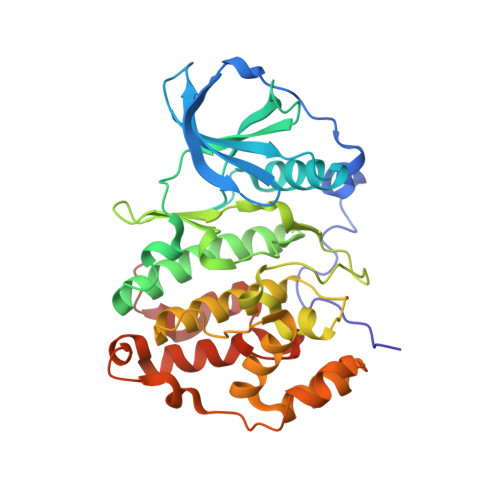Specific inhibition of CK2 alpha from an anchor outside the active site.
Brear, P., De Fusco, C., Hadje Georgiou, K., Francis-Newton, N.J., Stubbs, C.J., Sore, H.F., Venkitaraman, A.R., Abell, C., Spring, D.R., Hyvonen, M.(2016) Chem Sci 7: 6839-6845
- PubMed: 28451126
- DOI: https://doi.org/10.1039/c6sc02335e
- Primary Citation of Related Structures:
5CLP, 5CS6, 5CSH, 5CSP, 5CSV, 5CU3, 5CU4, 5CU6, 5CVF, 5CVG, 5CVH - PubMed Abstract:
The development of selective inhibitors of protein kinases is challenging because of the significant conservation of the ATP binding site. Here, we describe a new mechanism by which the protein kinase CK2¦Á can be selectively inhibited using features outside the ATP site. We have identified a new binding site for small molecules on CK2¦Á adjacent to the ATP site and behind the ¦ÁD loop, termed the ¦ÁD pocket. An elaborated fragment anchored in this site has been linked with a low affinity fragment binding in the ATP site, creating a novel and selective inhibitor (CAM4066) that binds CK2¦Á with a K d of 320 nM and shows significantly improved selectivity compared to other CK2¦Á inhibitors. CAM4066 shows target engagement in several cell lines and similar potency to clinical trial candidate CX4945. Our data demonstrate that targeting a poorly conserved, cryptic pocket allows inhibition of CK2¦Á via a novel mechanism, enabling the development of a new generation of selective CK2¦Á inhibitors.
Organizational Affiliation:
Department of Biochemistry , University of Cambridge , 80 Tennis Court Road , Cambridge CB2 1GA , UK . Email: mh256@cam.ac.uk.


















